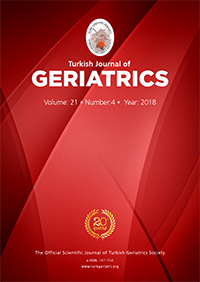2Ä°stanbul Physical Therapy and Rehabilitation Training and Research Hospital, Physical Medicine and Rehabilitation Clinic, Ä°stanbul, Turkey DOI : 10.31086/tjgeri.2018.62 Introduction: Lumbar spinal stenosis is a disorder that may cause low back and/or leg pain. This study aimed to evaluate the efficacy of pulsed electromagnetic field therapy in lomber spinal stenosis.
Materials and method: This study is single-blind randomised controlled study. Fifty patients diagnosed with lomber spinal stenosis were randomised into two groups. Patients in the first group [median age 61 (51-84) years] underwent 10 sessions of active pulsed electromagnetic field therapy (25 Hz, 80 gauss) for 15 minutes a day, whereas those in the second group [median age 64 (55-77) years] were controls and underwent 10 sessions of placebo pulsed electromagnetic field therapy. The patients were assessed with VAS, the Timed Up and Go test, Oswestry Disability Index and EQ5D-VAS. All tests were completed at baseline, after treatment and at a 3-week follow-up.
Results: Forty-nine patients completed the study. The pulsed electromagnetic field therapy group significantly improved VAS score, Oswestry Disability Index and EQ5D-VAS (p<0.05) after treatment. Significant improvement was sustained after 3-week follow up. In the placebo group, there was no significant change in VAS score, Oswestry Disability Index or EQ5D-VAS (p>0.05) after treatment. Pulsed electromagnetic field therapy group showed significant improvement than plasebo group in terms of pain severity, Oswestry Disability Index, EQ5D-VAS and Timed Up and Go after treatment and at follow-up (p<0.05).
Conclusion: Pulsed electromagnetic field therapy appears to be useful in terms of back and/or leg pain, functional mobility, physical disability and general health-related quality of life in lumbar spinal stenosis patients.
Keywords : Spinal stenosis; Magnetic fields; Back pain; Quality of life
